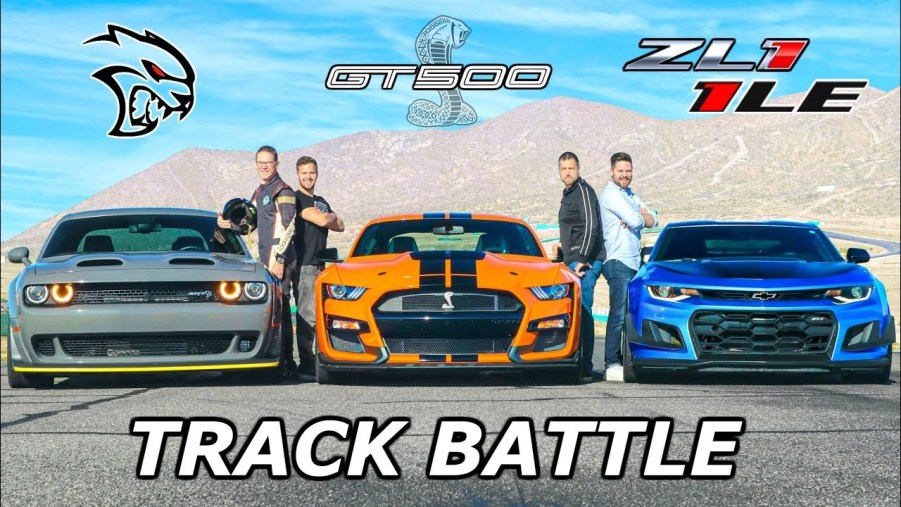
Who Makes the Ultimate Muscle Car: Ford, Chevy, or Dodge?
Despite the popularity of off-road SUVs like the Wrangler, muscle cars still loom large. Perhaps the best example is the Dodge Challenger, unchanged in 13 years. But its sales have grown with the help of high-powered models like the Hellcat and Demon, and it’s also earned above-average reliability scores from Consumer Reports. In contrast, the Chevy Camaro has been updated consistently, culminating in the world-record-holding Camaro ZL1 1LE. And now, the Shelby GT500, a Ford Mustang with supercar-levels of power, has joined the fight. But which is the ultimate muscle car?

YouTube team Throttle House wanted to find out. So, they gathered together a 2020 Ford Mustang Shelby GT500, a Camaro ZL1 1LE, and a Dodge Challenger Hellcat Redeye. They also brought in some help: veteran journalist Jason Cammisa and veteran racing driver Randy Pobst.
The muscle cars competing
The Shelby GT500 isn’t quite as fast as the new mid-engine Corvette, but it’s still impressive. Road & Track recorded a 0-60 time of 3.3 seconds, with the Shelby GT500 running the ¼-mile in 10.6 seconds.

And only part of that comes from its engine, a 5.2-liter supercharged V8 developing 760 hp and 625 lb-ft, according to The Drive. The GT500 also has active magnetic dampers, launch control, a Drag Mode, and a 7-speed dual-clutch transmission that, according to R&T, has “overclocked” shift paddles. Rounding out the tech is an optional carbon-fiber package that adds carbon-fiber wheels, carbon-fiber rear wing, and Michelin Pilot Sport Cup 2 tires.
But the Camaro ZL1 1LE isn’t exactly a slouch. The Throttle House hosts even claim it’s the fastest car to ever grace their Canadian test circuit. Like the GT500, it has a supercharged engine, a 6.2-liter V8 making 650 hp and 650 lb-ft, according to Car and Driver. It also has a carbon-fiber wing but paired with a front splitter. It doesn’t get magnetic dampers; instead, R&T reports it has Multimatic spool-valve dampers, which are just as good, but lighter. And unlike the Mustang, you can get it with a stick.
The Camaro ZL1 1LE impressed R&T so much, it placed second in the 2018 Performance Car of the Year, losing out to 4-5 times more expensive McLaren.

Finally, the Challenger Hellcat Redeye. As Autoweek reports, this is a ‘normal’ Challenger Hellcat, tweaked to deliver 797 hp and 707 lb-ft. The Redeye also has fender flares, necessary to clear its wider tires, and adaptive Bilstein shocks. It’s only 0.1 seconds slower to 60 than the GT500, but its top speed is higher: 203 mph. According to The Drive, it’s the cheapest two-door production car to break the 200-mph barrier.
How the cars were tested
Being a muscle car test, Throttle House started off with a ¼-mile drag race. They then ran a ¼-mile rolling drag race, with the cars starting at 50 mph. Because these cars come with various electronic aids, a normal drag race is as much about transmission and software tuning as it is about tires and engine. But a rolling drag race takes the software away, testing engine performance and traction only.
Finally, Randy Pobst took each muscle car out on the Big Willow track of the Streets of Willow raceway to set a lap time.
How did the cars perform?

To start, the Chevy Camaro ZL1 1LE needs an asterisk. The 1LE is so track-focused—R&T called it “the greatest track car GM has ever made”—its aero meant it would always lose drag races. So, for the drag races, the hosts swapped it out for the ‘normal’ ZL1: same engine and 10-speed automatic, but no aero.
The first drag race was won by the Camaro ZL1. Cammisa noted that the Redeye, even with its wide tires, struggles to put its 797 hp down unless it’s on a specially-prepared surface. And the GT500’s launch control has a full second of delay built-in. Thus, the ZL1 finished first, the GT500 second, and the Redeye third.
However, in the rolling drag race, the results were reversed. The Redeye has the most power and the most torque—it won handily. The GT500, with only slightly less power, came in second, and the ZL1 finished last.
Finally, the lap times. The ZL1 1LE finished in 1:27.20, the GT500 in 1:28.15, and the Hellcat Redeye in 1:32.59. The Redeye’s position was predictable: it’s not a track car, even with wide tires and adaptive suspension. Pobst may have hit 150 mph down the long straight, but the car struggled in the corners, and its tires weren’t designed for track use.
In contrast, Pobst praised the 1LE’s tires, brakes, handling, and transmission. It couldn’t quite reach the Redeye’s top speed, but it was able to carry more speed through the corners.

Interestingly, though, the GT500 should have won. Pobst claimed it out-sped the 1LE by 10 mph on the long straight and even said that “Carroll Shelby would be proud” of it. But it arrived on used Cup 2 tires. If the tires had been fresh, the GT500 would’ve been fastest.
Which is the ultimate muscle car?
Going by drag-race tradition, it may seem like the Challenger is the best muscle car. It also has the youngest buyers. But considering it lost the standing ¼-mile, and its poor track performance, none of the hosts would have it.

Pobst preferred the ZL1 1LE. It’s roughly $20,000 cheaper than the Mustang, and he’s a big fan of the Camaro’s platform and performance. However, the other hosts noted that it rides harshly in the real world, and its wide tires make it follow every groove in the road. It also has rather poor visibility.
So, 3 votes to 1, the Ford Mustang Shelby GT500 takes the ultimate muscle car crown.
Follow more updates from MotorBiscuit on our Facebook page.


